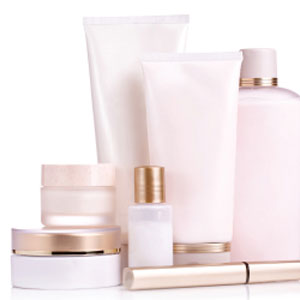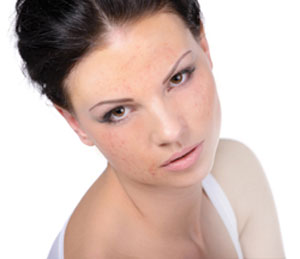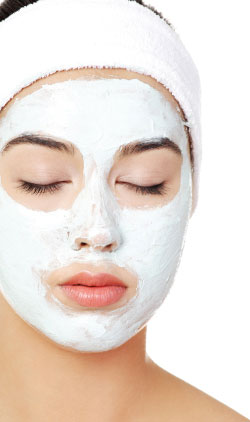Acne cosmetica is a term that was first coined in 1972 by dermatologists Albert M. Kligman and Otto H. Mills to represent the post-adolescent acne they believed was caused by cosmetic use. This is a complicated topic as its discussion involves the debunking of the common term “comedogenic,” the discussion of raw materials versus finished cosmetic products, as well as the fact that acne cosmetica affects both males and females. When properly identified, it is typically easy to clear and rarely causes scarring, making it a relatively easy form of acne to treat. We will address the salient points about this condition, in addition to highlighting effective strategies for treatment.
 What is Acne Cosmetica?
What is Acne Cosmetica?
As the name suggests, acne cosmetica is a form of acne triggered by the use of cosmetic products. This is certainly not limited to makeup, as any products applied to the face and the surrounding areas can instigate this type of breakout – hair gels, conditioners, and so on. This condition can occur in males or females, even those not previously predisposed to acne breakouts. Acne cosmetica affects areas like the cheeks and forehead where cosmetics, hair care products, and lotions are most frequently applied. The condition develops over a period of weeks or months and appears as small, itchy, or rash-like pink bumps. If changes in product use, hygiene practices, or application techniques are not altered, the condition may persist indefinitely.
Many think that the key to avoiding acne cosmetica is simply avoiding ingredients that are considered comedogenic. This opens a whole new discussion – what is comedogenicity and is it useful in determining who might be prone to acne cosmetica?
The Comedogenicity Conundrum
Comedogenicity is an over-used, yet elusive, concept that was introduced in medicine and the cosmetic industry several decades ago. It was recently re-evaluated, and is rarely used in science today. That said, it is still prevalent in marketing materials, causing confusion amongst consumers.
The concept of acne cosmetica was first developed to link the use of certain ingredients to comedo formation. Animal models were originally used to determine the comedogenic potential of single ingredients (like the rabbit ear test), with the assumption that finished formulations containing these ingredients would also be comedogenic. Making assumptions about a finished product based on animal models of one ingredient proved to be unreliable. Multiple researchers studying the same ingredient even obtained differing test results. The link between the comedogenic potential of single ingredients and finished products was never established; many finished products containing ingredients identified as comedogenic did not instigate comedo formation. A study published in the Journal of the American Academy of Dermatology in 2006 tested finished products containing ingredients that had been previously dubbed comedogenic. The results of the study found that the finished products containing these purported comedogenic ingredients were, in fact, not pore clogging or comedo forming. Upon re-evaluation of the data, many researchers rescinded their lists of comedogenic ingredients; even Dr. Kligman revoked his own claims on the comedogenicity of petrolatum.
We now know that it is unrealistic to try and determine comedogenicity simply by looking at the ingredient listing of a product. The properties of a particular finished product depend on the formulation, amount, and delivery format (cream, lotion, gel, solution, and so on). If particular ingredients consistently caused clogging of pores and breakouts, nobody would use them, as no one wants something that makes them break out, regardless of how dry their skin may be. Certainly some clients can develop allergic reactions, atopic dermatitis, or other negative outcomes from any number of ingredients, but this does not mean that they are comedogenic. The most reliable test for whether a finished product is likely to cause breakouts is a clinical study on human beings, which would show any undesirable link between the product formulation and comedo formation. This is a far more reliable strategy than testing raw materials on rabbit ears.
 Other Causes
Other Causes
In addition to the products used, the way they are applied, as well as whether they are effectively removed, play large roles in the development – and ultimately the clearing – of acne cosmetica. Dirty makeup brushes, often shared amongst friends in high school bathrooms, are bacterial havens. Additionally, these brushes are likely cleaned infrequently, exacerbating the situation. Disposable applicators should be used whenever possible to avoid this issue. Otherwise, brushes should be washed frequently and used only by their owner.
Another challenge is the cycle that many girls find themselves stuck in – thick makeup that causes breakouts, which is then used in even greater amounts to cover resultant breakouts. Finding a good, non-oily foundation that is right for the client’s skin type and condition is critical. Mineral makeups can be great choices for many acne cosmetica sufferers. The minerals can cause atopic dermatitis in some; however, this is not common.
Oftentimes, both boys and girls use hair styling products that travel to the forehead, cheeks, and jaw throughout the day. This can be made worse by sweating, wearing ball caps, and infrequent washing and hydration of their skin.
Strategies for Treatment Lifestyle
Girls who wear makeup should be educated about the importance of twice-daily gentle cleansing. Removal of dirt, debris, and makeup from the day should be done at night before bed and cleansing should occur again in the morning to remove sweat, saliva, and any other toxins excreted during sleep. This gives the client a clean canvas to apply their selected cosmetic or styling products.
Boys and girls who use hair styling products that can potentially travel to the forehead or jaw should get in the habit of showering before bed to avoid these products getting on their pillowcases, as well as sleeping on product-filled hair. Pillowcases are not often thought of as offenders in challenging skin conditions, but sleeping on a clean pillowcase can do wonders to speed the clearing of acne cosmetica. If it is unrealistic to change pillowcases every day or every several days, a clean, white cotton T-shirt can be draped over the pillow prior to sleeping.
 Daily Care
Daily Care
Once you have made the causes of their breakouts clear to the client and identified the offending products, the next step is to begin a simple, yet effective skin care regimen. The most important products are a gentle cleanser that is appropriate for each individual’s skin type. Remember, just because a person is reacting to a topically applied cosmetic or hair care product with breakouts does not mean that they have oily or acneic skin. Ask copious questions during the client consultation so you can try to discern their true skin type.
While trying to clear breakouts initially, it may be wise to introduce an antibacterial serum to help kill the bacteria present. The use of this product may be temporary, to be replaced by an antioxidant serum when the breakouts are cleared.
Additionally, it is critical that clients understand that sunscreen use is non-negotiable. Acne cosmetica is typically quite inflamed and additional inflammation due to ultraviolet exposure will do nothing but worsen the condition. Even if the client is young and not fully onboard with daily sunscreen use, tie it to clearing the breakouts and compliance will be more likely. There are light and quick-absorbing formulations on the market today for those suffering with acne cosmetica.
Daily hydration is also highly important. Teenagers who are breaking out find it difficult to understand the need for hydration. Choose a nighttime hydrator that contains antibacterial components and a light texture.
Each client is unique. You may have some who want additional products to address their concerns, but this simple three to four product regimen is a good starting point.
Professional Treatments
Having a gentle, blended, superficial chemical peel can help to kick-start improvement. Often these clients have used harsh, drying products in an attempt to clear the breakouts, not realizing it is one of their cosmetic products that is causing the problem. If the surface of the skin is overly dehydrated, it becomes even more impacted and dull. This allows the bacteria present in the skin to proliferate, worsening the condition. By reducing impaction and killing bacteria, the skin will function more effectively and begin to take on a healthy glow rather than an inflamed, yet dull appearance.
There are also a number of masks that can be quite beneficial; salicylic acid masks and enzyme formulations can be a good place to start with a younger client who may not feel ready for a peel. Applying a peel solution on the back of a young client’s hand may help to allay any fears they may have.
Once the offending cosmetic product or products are identified and eliminated, proper education and the introduction of a simple, yet effective, daily regimen and a series of professionally applied treatments can clear acne cosmetica, leaving these clients with clear, glowing and healthy skin.
 Jennifer Linder, M.D., serves as Chief Scientific Officer for PCA SKIN®, guiding all product development and clinical trials for the company. A board-certified dermatologist and a fellowship-trained skin cancer surgeon using the Mohs micrographic technique, Dr. Linder is one of the foremost U.S. experts in the use of the cosmetic filler, Sculptra. She holds a clinical faculty position in the Department of Dermatology at the University of California,
Jennifer Linder, M.D., serves as Chief Scientific Officer for PCA SKIN®, guiding all product development and clinical trials for the company. A board-certified dermatologist and a fellowship-trained skin cancer surgeon using the Mohs micrographic technique, Dr. Linder is one of the foremost U.S. experts in the use of the cosmetic filler, Sculptra. She holds a clinical faculty position in the Department of Dermatology at the University of California,
San Francisco.
Want to read more?
Subscribe to one of our monthly plans to continue reading this article.